Please click here to access the main AHDB website and other sectors.
- Home
- Knowledge library
- Recognition and biology of sciarid and shore flies in protected ornamentals
Recognition and biology of sciarid and shore flies in protected ornamentals
Understand how to recognise sciarid and shore flies and learn key information about their biology.
Sciarid flies are known as fungus gnats in North America as their larvae feed on diseased and rotting plant material in the growing media, as well as sometimes causing primary damage to roots and underground stems. The most common species in UK protected crops is Bradysia difformis (formerly known as Bradysia paupera), but other species of Bradysia and some Lycoriella species may also occur. The description of life stages and biology below are for B. difformis.
Adults
The adult is a small, black, gnat-like fly, about 2 mm long, with iridescent wings, often seen running around the rims of pots or trays or flying weakly around the plants or growing media. The females are slightly larger than the males. Sciarid flies can be distinguished from shore flies and other small black flies by their long legs, long, beaded antennae and a distinctive Y-shaped vein on each wing. The adults live for up to 10 days at 10°C, three to four days at 20°C and only one day at 30°C.
Eggs
Once mated, the females lay eggs in warm, damp growing media. They are attracted to lay eggs in media high in organic matter, including those with diseased and decaying plant material. The eggs are usually laid in clumps, either on or into small cracks and hollows just below the surface of the growing media. They are oval, 0.1–0.2 mm long and transparent when laid, turning milky white just before hatching. Each female can lay over 100 eggs during her life at 15–25°C but less than 50 at 10°C.
Sciarid fly eggs are laid in clumps in damp growing media rich in organic matter
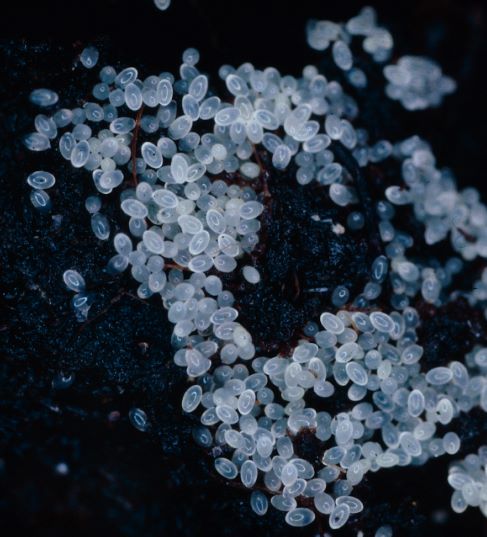
Courtesy and copyright ADAS Horticulture.
Larvae
The eggs hatch into young larvae after five to seven days at 15–25°C, but egg hatch is slower at cooler temperatures, for example, 14 days at 10°C. There are four larval stages (instars), each larger than the previous one, reaching a length of up to around 5 mm. The larvae have no legs and a distinctive black head capsule. The young instars are transparent and the largest, fourth instar, is white, but the green or brown gut contents can always be seen moving around inside the body. At 10°C and below, the larvae do not complete development. The larvae feed for five days at 25–30°C, eight days at 20°C or 16 days at 15°C before pupating.
Sciarid fly larva with black head capsule (left) and gut contents visible in transparent body
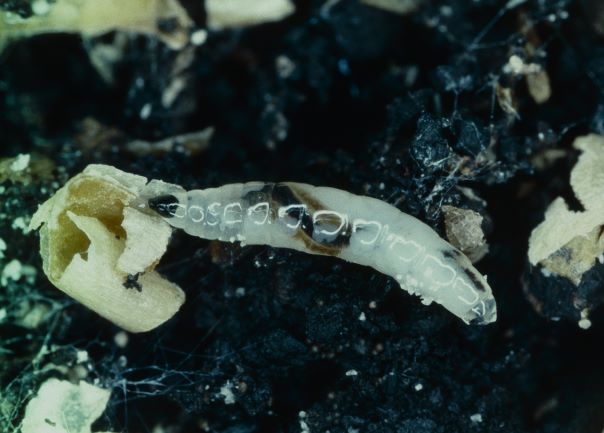
Courtesy and copyright ADAS Horticulture.
Pupae
The larvae pupate in the growing media. The pupae are white, turning brownish just before adult emergence. When the pupa is ready to emerge, it moves up to the surface of the growing media so that the new adult fly can emerge. The pupal stage lasts for three to seven days, depending on temperature.
Sciarid fly pupa
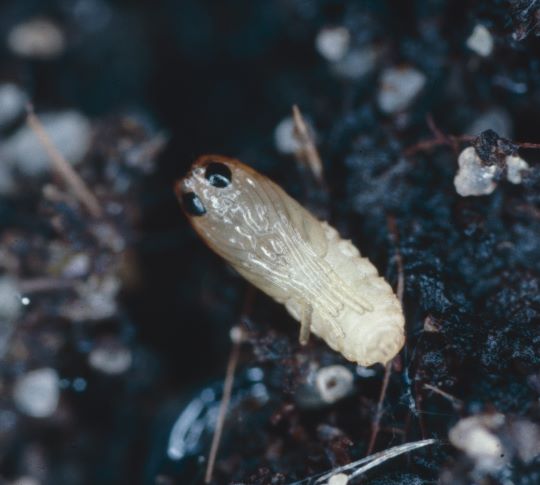
Courtesy and copyright ADAS Horticulture.
Sciarid fly development rates
Sciarid flies are more of a problem in warmer temperatures between spring and autumn, but breeding can continue all year in heated glasshouses. Bradysia difformis takes 15-17 days to develop from egg to adult at 25–30°C, 21 days at 20°C and 34 days at 15°C. Therefore in heated structures and during the summer months, it can complete many generations and build up large numbers if left uncontrolled.
Sciarid fly adult with long legs, long antennae and iridescent wings

Courtesy and copyright of ADAS Horticulture.
Shore flies
Shore flies in protected UK crops were previously reported as Scatella stagnalis, but identification in HDC/AHDB-funded project PC 239 confirmed shore flies on protected ornamentals, herbs and celery as Scatella tenuicosta.
Adults
The adult is a small, robust black fly like a miniature house fly, about 4 mm long, often seen sitting on plants, growing media, bench or floor coverings. The antennae are short and stubby, and each wing has five pale spots, giving a ‘domino’ effect. The adults are active flyers and fly off quickly if disturbed.
Eggs
The females lay eggs singly onto the surface of growing media or any other surface supporting fresh, active algal growth. The eggs are oval, about 0.4 mm long and opaque white, with a net-like pattern on the surface. Each female can live for two to three weeks depending on temperature and can lay almost 500 eggs during her life at 26°C.
Shore fly egg with a net-like pattern on the surface
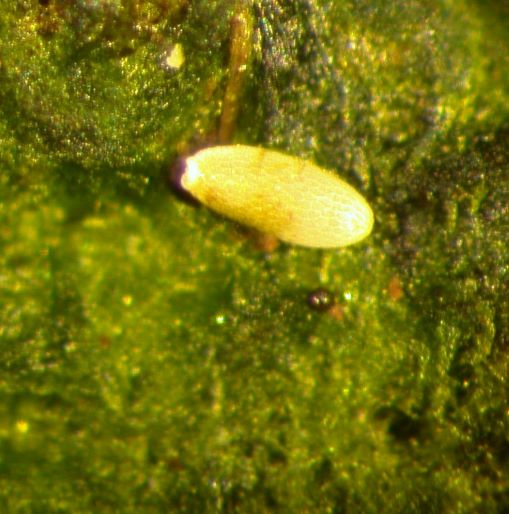
Courtesy and copyright of ADAS Horticulture.
Larvae
The three shore fly larval stages are transparent, allowing the brown gut contents to be seen through the body wall so that they appear to be brown; thus the larvae are difficult to see on the surface of the growing media or substrate.
Shore fly larvae on the surface of growing media
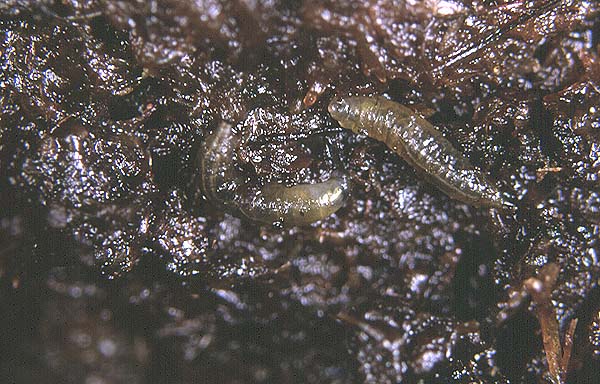
Courtesy and copyright of Nigel Cattlin.
Pupae
The pupae are brown and tapered at both ends, and both larvae and pupae have two spiracles (‘breathing tubes’) at the rear end, which have black tips.
Shore fly pupa with two ‘breathing tubes’ at the rear (bottom) end
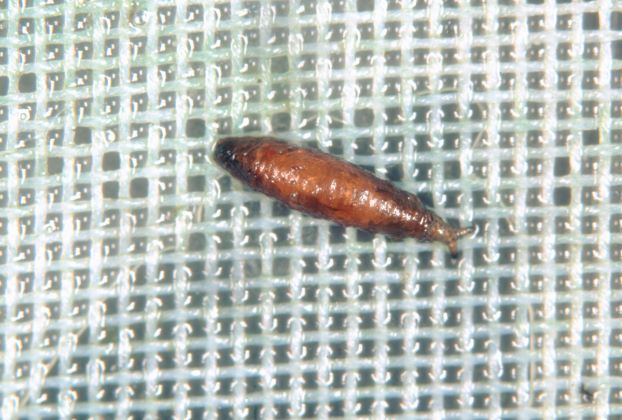
Courtesy and copyright of Nigel Cattlin.
Shore fly development rates
Shore flies breed quickly in warm temperatures and can occur in large numbers in wet areas with fresh algal growth. The flies are often more numerous on young and slower growing species such as Begonia and Cyclamen because these subjects cover the growing medium more slowly, allowing relatively more algal growth in the early production stage. Therefore prpagation areas where young plants in plug trays are watered frequently are ideal breeding grounds.
The minimum temperature for the development of Scatella tenuicosta from egg to adult is 6.4°C and very few complete their development below 10°C. The development time from egg to adult is faster with increasing temperature; development takes 16 days at 20°C, 11 days at 25°C and 10 days at fluctuating summer glasshouse temperatures of 23–34°C (mean 28.5°C). The population can double in five days at 25°C and in only two days at 28.5°C. Thus shore fly populations can increase much faster than those of sciarid flies in warm, wet conditions.
Shore fly adult with a stout body, short antennae and pale ‘domino’ spots on the wings
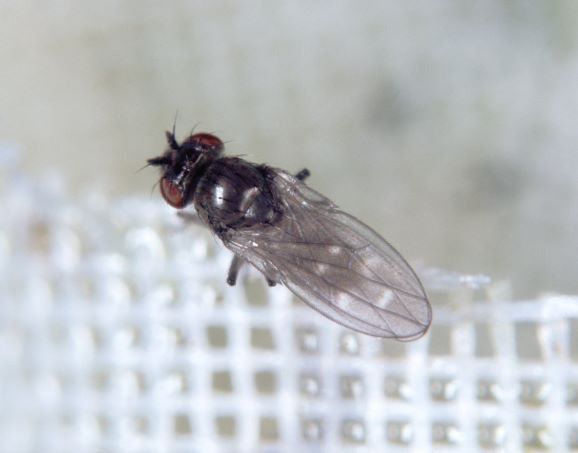
Courtesy and copyright of Nigel Cattlin.
Useful links
Read the AHDB Bedding and Pot Plants Crop Walkers' Guide for more information on sciarid and shore flies and other common pests of protected ornamentals.
AHDB Bedding and Pot Plants Crop Walkers’ Guide
Authors
Author – Jude Bennison. ADAS Horticulture.
Original author – John Buxton. ADAS Horticulture.
Webpage content correct as of May 2021.
Topics:
Sectors:
Tags:

